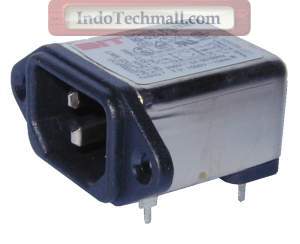
An anti-RFI filter

Rp 30.000,-
Everyone knows that a correct
and clean power from the mains is a MUST for any serious HiFi
system. Any electromagnetic interference that flows through the
mains and reachs your HiFi system can unpredictably affect the
overall performance of any component.
For this reason, during the last years, we've seen more and more
power conditioners, line filters and similar devices starting to
crowd the HiFi market.
Sometimes these devices are pretty expen$ive, even when they're
nothing more than an isolation transformer (1:1) followed by a
anti-RFI filter
Also, their effectiveness relies much on the kind of HiFi
components we plug into it. Satisfaction isn't always guaranteed
and a careful listening test at home should be performed before
buying, just to avoid any surprise (I'm assuming your bucks are
hard-earned, like ours).
Now let's assume you're searching for some device that can eliminate the interferences into the mains, without spending an arm and a leg. Or let's suppose you're quite skeptic about the importance to minimize the interferences into an HiFi chain.
Here's the solution: you can buy
a filtered IEC socket as the one in the picture above and change
the old normal IEC socket of your HiFi components.
These filtered sockets have a small built-in ANTI-RFI filter that
attenuates the intereferences ranging from 0,1 Mhz up to 150 MHz
of an interesting 50dB amount.
The built-in filter usually has three caps and two inductances,
everything being inside a sealed metal little box (the socket
itself).
You can hook up till 660 VA (@ 220V) or, equivalently, 3
Amperes.
Normally these are known as pi-filters or Shaffner filters, from
the name of the brand that started to produce these in a large
scale.
There are different models available, even a more complex one
which makes use of an inductance on the ground line.
Installing a mains filter like this is incredibly easy: just take away the old IEC mains socket and replace it with the filtered one. This is all. Once you've finished the installation nobody can detect the work you've done to your HiFi component.
These filters are easy to find:
any electronic parts or even computers store should have them in
stock. Otherwise you can buy them on the ubiquitous
RS
catalogue.
The price is variable, depending on the kind of filter you buy,
just to give you an idea the price range is between 10$ and 25$.
As remarked above, any action
devoted to improve the quality of the mains does have some effect
on the overall performance of any HiFi system. A simple anti-RFI filter is just the first and effective step: how much this
filter can improve the performance of a given component is very
hard to tell since much of this depends on the quality of the
mains into your home.
Sometimes the results are outstanding, other times are just
slightly audible. Of course, everything depends also on the level
of transparency of your system: don't expect unbelievable
improvements if your HiFi system isn't correctly installed and
already optimized.
I can tell you what these filters have done to my HiFi
components.
First of all I've tried one of these sockets with my TV set: I
always experienced the annoying presence of nasty noises and
horizontal rows when someone was using another electrical
appliance at home, such as hair blowers or vacuum cleaners.
Everything disappeared as soon as the filter was installed, so
effectively that I was ready for the big jump: if these devices
are so effective with the TV, what could they do to my HiFi?
I had a problem with my HiFi systems: they sounded different
depending on the hours of the day. The filter has almost totally
solved this annoying problem and now I can listen to my fav Music
at any hour of the day.
Now the bass range is slightly deeper and the image better
focused and realistic. Nothing that will make you stand up and
applause but...yet something clearly audible.
You can use these filters with your CD player, D/A converter,
turntable and with the preamplifier. Using these with an
amplifier or power amplifier should be carefully evaluated before
installing.
If the HiFi component you want to filter doesn't have an IEC
socket (that is, a detachable power cord) you can always drill a
hole in the cabinet (voiding the warranty, of course!) and
install the new filtered socket. Obviously enough you'll need an
IEC plug terminated power cable.
If you're trying to understand what a dirty mains can do to your Music, try one of these filters: they're are cheap and easy to install.